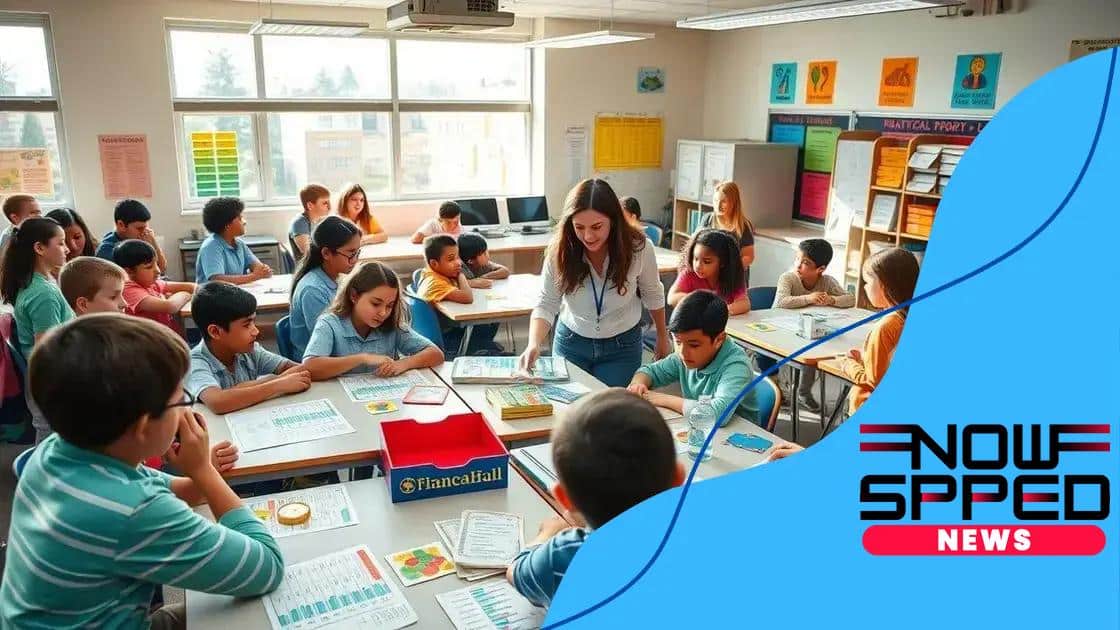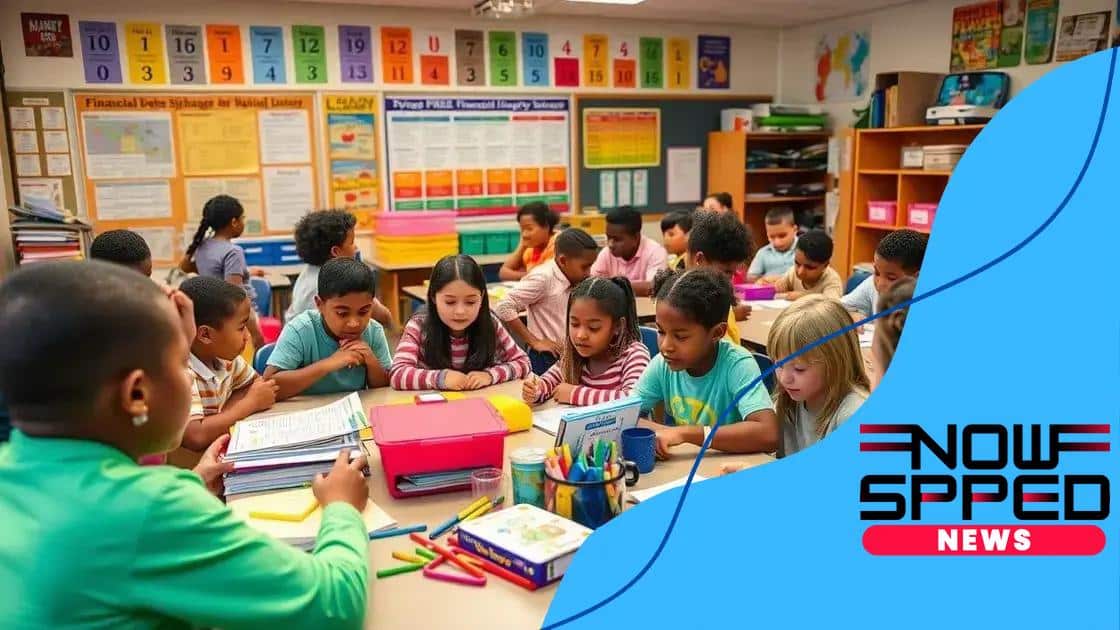Financial literacy education for middle school students

Financial literacy education for middle school students equips them with essential skills in budgeting, saving, and investing, enabling informed financial decisions and fostering long-term financial health.
Financial literacy education for middle school students is not just about numbers; it’s a vital skill set that helps young people navigate their financial futures. Have you ever wondered how knowledge of money management can shape their choices?
Understanding the importance of financial literacy
Understanding the importance of financial literacy is essential for middle school students as they begin to manage their own money. It sets the foundation for smart financial decisions later in life.
Financial literacy is more than just knowing how to add or subtract. It involves understanding how to save, budget, and spend wisely. This knowledge can empower students to take control of their financial futures.
The benefits of being financially literate
Teaching financial literacy has several key benefits. By learning early, students can:
- Make informed decisions about spending and saving.
- Avoid unnecessary debt as they grow older.
- Understand the value of investing and how it works.
Engaging students with interactive lessons can make learning about finance fun. For instance, games like “Monopoly” teach important concepts about money management without feeling like a chore. Conversations at home about money can also reinforce what they learn in school.
Real-world applications
Knowing how to budget is one of the most important skills students can learn. They might wonder how to save for a new video game or a bike, for example. A simple budget helps them track their savings and understand the impact of their spending choices.
Real-life scenarios, like planning a small event, can help students see the practical side of financial literacy. They can create a budget for snacks, decorations, and invitations, allowing them to experience firsthand the significance of managing money effectively.
Key concepts in personal finance
Understanding key concepts in personal finance is crucial for middle school students. These fundamental ideas help them navigate their financial future with confidence.
Personal finance covers various topics that everyone should know. It includes budgeting, saving, investing, and understanding credit.
Budgeting Basics
Creating a budget is the first step every student should take. A budget helps them track their income and expenses. Here are some points to consider:
- Identify sources of income, like allowances or jobs.
- List all monthly expenses, including school supplies and snacks.
- Set limits to avoid overspending.
Once students create a budget, they can learn to stick to it. This teaches discipline and planning.
Importance of Saving
Saving money is essential for achieving goals. Whether it’s a new game or a trip, having savings can make dreams come true. Students should learn:
- To set aside a percentage of their income.
- The benefits of having an emergency fund.
- Ways to save, like opening a piggy bank or account.
By understanding the significance of saving, they become better prepared for unexpected expenses.
Another important concept is investing. Learning about it at a young age can provide a head start. Students can explore how investments work and the potential for growth. Discussing simple examples, like investing in a lemonade stand, can make it relatable.
Understanding credit is also vital. Teaching students about credit scores and how to build good credit helps them make wise choices in the future.
Interactive activities for middle school students

Engaging students through interactive activities for middle school students makes learning about financial literacy enjoyable. These activities can help students grasp important concepts in a fun way.
Using games and simulations encourages participation and critical thinking. For example, a class can play a budgeting game where each student manages a virtual household budget. They can make decisions on rent, food, and entertainment. This real-life scenario makes learning relevant.
Group Projects
Group projects also foster collaboration while teaching financial concepts. Students can work together to create a business plan for a small venture, such as a school store. They will learn:
- How to calculate costs and potential profits.
- The importance of marketing and selling.
- Planning budgets and managing finances.
These hands-on experiences provide valuable lessons while enhancing teamwork skills.
Workshops and Guest Speakers
Inviting guest speakers from various financial backgrounds can inspire students. They could hear stories from entrepreneurs, bankers, or financial coaches. These speakers can highlight the importance of saving and investing.
Workshops can also be an effective tool. Students might participate in budgeting seminars where they practice using calculators to manage expenses. These experiences help reinforce the skills they learn in class.
Combining technology with traditional lessons can also captivate students’ interests. Using online budgeting tools and apps during lessons can make the material more relatable. Students can visualize their finances and track expenses through engaging digital platforms.
Tools and resources for teaching finance
Having the right tools and resources for teaching finance can make a significant difference in how students grasp essential financial concepts. Teachers can utilize various materials to enhance their lessons and engage middle school students effectively.
One great starting point is educational websites that offer financial literacy curricula. These resources often include lesson plans, interactive activities, and videos that explain complex topics in simple terms.
Online Platforms
Many online platforms provide simulations and games that teach money management skills. Some popular tools include:
- Virtual budgeting apps that allow students to create budgets using a virtual income.
- Financial planning games that simulate real-life financial decisions.
- Interactive quizzes to test knowledge on personal finance topics.
Using these platforms can help students practice their skills in a fun and engaging way. They allow for hands-on learning, which tends to be more memorable.
Printed Materials
Printed resources can also be valuable. Worksheets and workbooks designed for financial literacy can reinforce lessons. These materials might cover topics such as saving, investing, and understanding interest rates. Students can work through exercises that provide real-life scenarios, enhancing critical thinking.
In addition to worksheets, having posters and visual aids around the classroom can spark interest. Illustrating key concepts visually helps students remember important ideas and terms.
Furthermore, teachers can collaborate with local financial institutions. Many banks and credit unions offer free resources for classrooms. These can include brochures, pamphlets, and even guest speakers who can share their expertise.
Engaging parents in financial education
Engaging parents in financial education is a crucial step toward ensuring that middle school students develop good money habits. When parents are involved, children receive more consistent messages about financial responsibility.
One effective way to involve parents is by hosting informational workshops. These workshops can cover various topics, such as budgeting, saving, and investing. Providing parents with practical tools can empower them to teach their children about finance at home.
Promoting Open Discussions
Encouraging open discussions about money can make a big difference. Parents can share their financial experiences, both successes and mistakes. This creates a safe environment for students to ask questions and express their thoughts about money. Parents should be encouraged to talk about the importance of saving for goals, like college or a car.
Resources to Share
Schools can provide parents with resources like brochures, articles, and links to educational websites. These materials can help parents understand basic financial concepts, making them more comfortable discussing these topics with their children. For example, simple guides on how to open a savings account can be helpful.
Additionally, schools can set up a financial literacy night where parents and students can participate in activities together. These activities can be fun and engaging, reinforcing the lessons learned in the classroom. Moreover, parents can play games that teach budgeting and finance while competing with their children.
Involving parents also helps to create a community of learners. By forming parent-teacher associations focused on financial literacy, schools can work together with families to promote better financial habits. This collaborative approach reinforces the importance of financial education and highlights its relevance to everyday life.
In conclusion, engaging middle school students in financial literacy education is essential for their future success. By teaching key concepts and involving parents in the learning process, we empower the next generation to make informed financial decisions. Activities that encourage interaction and practical application ensure these lessons stick. Together, educators, parents, and the community can create a solid foundation for healthy financial habits that will serve students for years to come. Let’s work together to inspire our young learners and foster confidence in their financial abilities.
FAQ – Frequently Asked Questions about Financial Literacy Education
Why is financial literacy important for middle school students?
Financial literacy is vital because it equips students with essential money management skills, helping them make informed decisions in their future.
How can parents get involved in their child’s financial education?
Parents can engage by attending workshops, discussing financial topics at home, and participating in school activities related to finance.
What are some effective interactive activities for teaching finance?
Activities such as budgeting games, simulations, and group projects can make learning about finance enjoyable and relatable.
What resources are available for teaching financial literacy?
There are numerous resources like educational websites, workshops, printed materials, and tools provided by financial institutions to support teaching.





